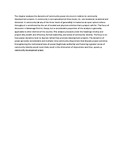| dc.contributor.author | Omoka, WK | |
| dc.contributor.author | Chitere, O | |
| dc.date.accessioned | 2015-06-18T13:59:08Z | |
| dc.date.available | 2015-06-18T13:59:08Z | |
| dc.date.issued | 1991 | |
| dc.identifier.citation | Working with rural communities: a participatory research perspective in Kenya. 1991 pp. 79-87 | en_US |
| dc.identifier.uri | http://www.cabdirect.org/abstracts/19931856528.html?resultNumber=7&q=ed%3A%22Mutiso%2C+R.%22 | |
| dc.identifier.uri | http://hdl.handle.net/11295/85144 | |
| dc.description.abstract | The chapter analyses the dynamics of community power structure in relation to community development projects. A community is conceptualized at three levels, viz. sub-locational, locational and divisional. A community (at any of the three levels of generality) is treated as an open system whose throughput is constituted by the set of mental and physical activities that a project calls for. The focus of discussion is Kakamega District, Kenya, but a considerable proportion of the analysis is generally applicable to other districts of the country. The analysis proceeds under the headings: kinship and project site; wealth and influence; formal leadership; and sense of community identity. The focus is on how power dynamics tend to depress rather than promote development projects. The dynamics of power generate considerable and multiple intra-community disjunctions that impede project activities. Strengthening the institutional base of power (legitimate authority) and fostering a greater sense of community identity would most likely result in the diminution of disjunctions and thus, speed up community development praxis. | en_US |
| dc.language.iso | en | en_US |
| dc.publisher | University of Nairobi | en_US |
| dc.title | Effect of community power on local development projects in Kakamega district. | en_US |
| dc.type | Article | en_US |
| dc.type.material | en | en_US |

